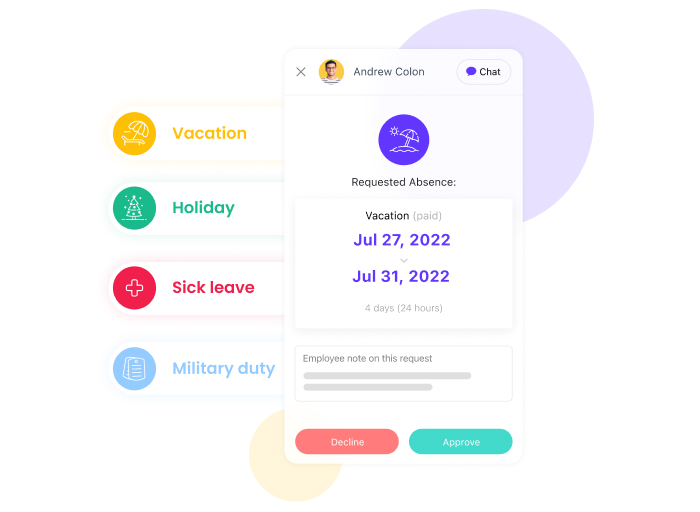With the holiday season around the corner, effective employee scheduling has never been more important—or challenging.
Limited employee availability and numerous time-off requests during such a busy time of year can be a headache. When mismanaged, ineffective holiday scheduling can leave you short-staffed and affect employee morale.
But here’s the good news—Christmas has come early for you this year. In this article, we explore how you can make your holiday scheduling a breeze with these easy steps.
Set Expectations Early
The first step to creating an effective holiday work schedule is to consider your business needs. Is the holiday season one of the busiest times of the year for your business? If so, how many staff do you need to cover it?
Alternatively, is it an opportunity to slow down and operate with limited staff? Clarity on this allows you to explain to your employees what to expect—and what is expected of them—when it comes to the holiday season.
Once you know what you need from your employees, develop your policies and processes around holiday work schedules and time-off requests. For example, you might set a deadline for employees to submit time-off requests or require each employee to work at least one weekend a month during the holiday season.
Consider how to manage clashing requests for time off. You might give preference to employees who covered the previous holiday season or require employees with less than 1 year’s service to be available. You may also want to set several “blackout” days that all employees are required to work.
Do this as early as possible. Knowing the holiday dates from the start of the year gives you plenty of time to plan your holiday scheduling.
Communicate Clearly and Often With Your Employees
Once you’ve decided how to approach your holiday scheduling policies and processes, communicate them to your employees. Do this as early as possible to ensure your employees aren’t taken by surprise and so they can manage their personal obligations around their shifts.
Discussing the issue of holiday schedules with your employees gives them the chance to raise any concerns, make suggestions, and ask any questions they have. By encouraging an open dialogue, you build a sense of camaraderie around the issue. Rather than being forced to work, your employees feel that they have some input into holiday scheduling decisions.
This process also helps you learn about your employees’ individual preferences. You may find some employees are willing to volunteer to work certain holiday shifts in exchange for taking others off.
Clear communication about holiday schedules also gives you and your workers certainty. They can decide when they want to use their paid time off (PTO) and you can maintain your business planning and reduce the risk of any staffing issues arising over the holiday period.
Consider Offering Company Holidays
If your business can afford to, consider offering your employees paid holidays. While not required by law, many employers choose to offer their employees paid leave on certain holidays—such as Labor Day, Independence Day, Veterans Day, Thanksgiving Day, Christmas Eve (December 24), Christmas Day (December 25), and New Year’s Day.
Closing over the holiday period isn’t an option for every business, especially those in the hospitality or tourism industries. But if you can, company holidays are an extra employee benefit you can offer your workers. It’s a good way to show your interest in their well-being and create goodwill with your employees.
Company holidays may also encourage your workers to volunteer to work on other days during the holiday season, or at least take some of the sting out of having to work other holidays.

Use an Employee Scheduling App
Managing the availability of your employees and numerous requests for time off during the holiday season can be a headache. Doing so manually is time-consuming and can lead to scheduling errors and miscommunication when any changes are made.
The easiest way to manage your business’ holiday scheduling is with an employee scheduling app. With a scheduling app, your employees can submit their time-off requests and you can create and communicate your holiday work schedule from a central place.
With their schedule available from any device, employees can check their roster, swap shifts, and receive instant notifications of any updates. You can also quickly see who is available on a certain day and integrate it with your payroll to manage holiday pay.
Simplify Holiday Scheduling with the #1 Tool for Managing Time Off.
Check employee availability, customize your time off policies, and communicate roster changes in real time all from one place.
Pay Holiday Rates
If you need staff to work on specific holidays, consider offering them holiday rates. You can decide to compensate them at a higher rate than usual—for example, 1.5 times or even double their regular rate of pay.
Doing so acknowledges the personal sacrifice they may make to work that day. This approach may also incentivize people to volunteer for unpopular shifts—such as New Year’s Day—reducing the risk of finding yourself short-staffed over busy periods.
Acknowledging your employees’ contributions over the holiday period isn’t limited to pay. You might consider giving your employees holiday gifts, hosting an office holiday party, allowing remote work on certain days for extra flexibility, or offering extra PTO after the holiday season.
Schedule Strategically
For many businesses, the holiday season can be one of the busiest times of the year. Effective holiday scheduling for this time involves not only ensuring you have enough staff, but also the right mix of staff.
When creating a holiday work schedule, be mindful of skills gaps. You need to ensure the employees you roster have complementary skills so that all aspects of the business are covered while it runs on skeleton staff. One way to do this is by pairing junior employees or seasonal workers with more experienced employees.
If you’re going to make do with less staff over the holiday period, ensure those who are rostered on are prepared. Provide them with any training they might need well in advance and ensure the employees taking leave prepare handover instructions where necessary.
Consider Hiring Seasonal Employees
If the holiday season means your business is booming, then consider temporarily hiring additional seasonal workers. If you go down this road, be very clear about your holiday policies and scheduling expectations during the hiring process. Hiring seasonal employees who aren’t available when you need them won’t help with your holiday scheduling.
It’s also essential to prepare seasonal employees through a well-designed onboarding process. While this may be adapted from the one you use for permanent employees, it still needs to cover all the information they need to know to get the job done.
Like your regular employees, you can give seasonal workers access to a scheduling app to register their availability. From there, you can easily manage any shift swaps and communicate updates to your entire workforce.
The #1 Tool for Managing Time Off.
Reduce scheduling errors and save time with Connecteam’s all-in-one time management software.
Holiday Scheduling Doesn’t Have To Give You a Headache
When preparing your holiday work schedule this year, keep the above tips in mind to make it as hassle free as possible. By developing fair policies and procedures around holiday scheduling in your organization, you can communicate your expectations at an early stage to employees.
An effective employee scheduling app is a good first step to effective holiday scheduling. Hiring extra seasonal employees, offering holiday pay or other benefits, or closing the office and giving your employees a company holiday can also help you and your employees enjoy the holiday season, both at and away from work.

